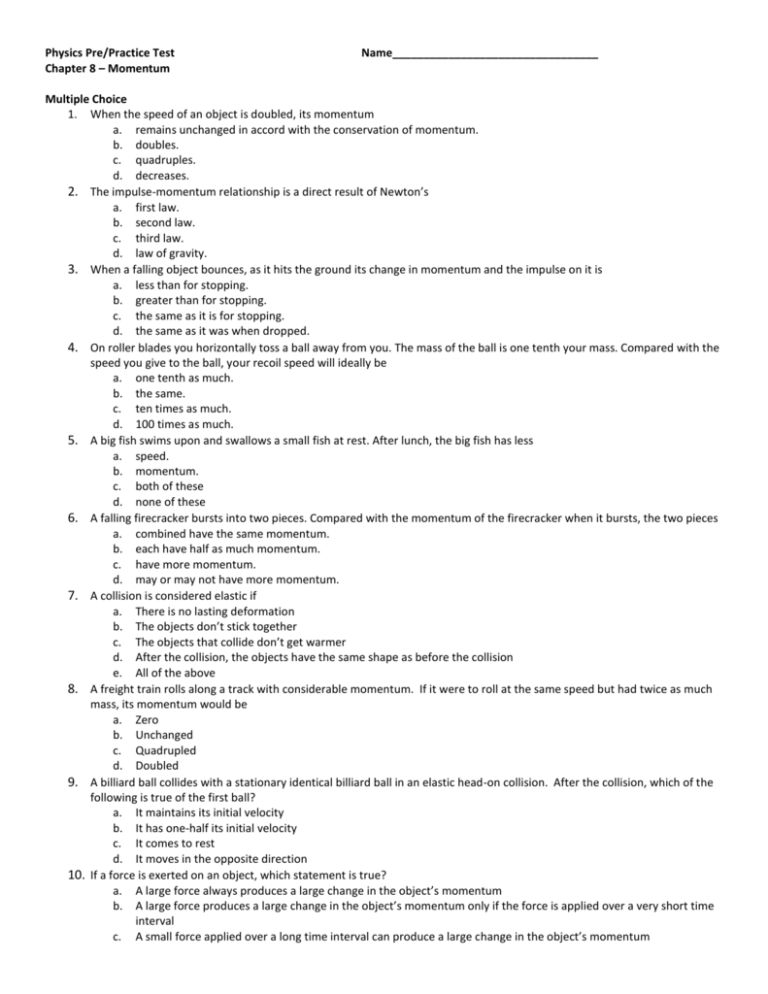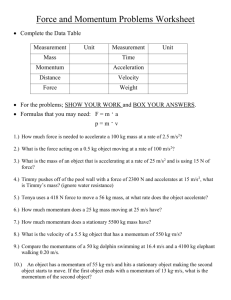Ch. 8 Momentum
advertisement

Physics Pre/Practice Test Chapter 8 – Momentum Name_________________________________ Multiple Choice 1. When the speed of an object is doubled, its momentum a. remains unchanged in accord with the conservation of momentum. b. doubles. c. quadruples. d. decreases. 2. The impulse-momentum relationship is a direct result of Newton’s a. first law. b. second law. c. third law. d. law of gravity. 3. When a falling object bounces, as it hits the ground its change in momentum and the impulse on it is a. less than for stopping. b. greater than for stopping. c. the same as it is for stopping. d. the same as it was when dropped. 4. On roller blades you horizontally toss a ball away from you. The mass of the ball is one tenth your mass. Compared with the speed you give to the ball, your recoil speed will ideally be a. one tenth as much. b. the same. c. ten times as much. d. 100 times as much. 5. A big fish swims upon and swallows a small fish at rest. After lunch, the big fish has less a. speed. b. momentum. c. both of these d. none of these 6. A falling firecracker bursts into two pieces. Compared with the momentum of the firecracker when it bursts, the two pieces a. combined have the same momentum. b. each have half as much momentum. c. have more momentum. d. may or may not have more momentum. 7. A collision is considered elastic if a. There is no lasting deformation b. The objects don’t stick together c. The objects that collide don’t get warmer d. After the collision, the objects have the same shape as before the collision e. All of the above 8. A freight train rolls along a track with considerable momentum. If it were to roll at the same speed but had twice as much mass, its momentum would be a. Zero b. Unchanged c. Quadrupled d. Doubled 9. A billiard ball collides with a stationary identical billiard ball in an elastic head-on collision. After the collision, which of the following is true of the first ball? a. It maintains its initial velocity b. It has one-half its initial velocity c. It comes to rest d. It moves in the opposite direction 10. If a force is exerted on an object, which statement is true? a. A large force always produces a large change in the object’s momentum b. A large force produces a large change in the object’s momentum only if the force is applied over a very short time interval c. A small force applied over a long time interval can produce a large change in the object’s momentum d. A small force always produces a large change in the object’s momentum Short Answer 11. What factors affect an object’s momentum? It’s impulse? 12. Describe a case where a roller skate and a truck would have the same momentum. 13. When a dish falls, will the impulse be less if it lands on a carpet than if it lands on a hard floor? Explain. 14. If a boxer is able to make the contact time five times longer by “riding” with the punch, how much will the force of the punch impact be reduced? 15. One glider is loaded so it has three times the mass of another glider. The loaded glider is initially at rest. The unloaded glider collides with the loaded glider and the two gliders stick together. Describe the motion of the gliders after the collision. Problem Solving 16. Consider a 6-kg fish that swims toward and swallows a 2-kg fish that is at rest. If the larger fish swims at 1 m/s, what is its velocity immediately after lunch? 17. Rework the problem above supposing the small fish is not at rest but is swimming toward the large fish at 2 m/s. 18. Jennifer, who has a mass of 50.0 kg, is riding at 35.0 m/s in her red sports car when she must suddenly slam on the brakes to avoid hitting a deer crossing the road. She strikes the air bag, that brings her body to a stop in 0.500 s. What average force does the seat belt exert on her? 19. If a 5-kg object experiences a 10-N force for a duration of 0.10-second, then what is the momentum change of the object? 20. A 3000-kg truck moving with a velocity of 10 m/s hits a 1000-kg parked car. The impact causes the 1000-kg car to be set in motion at 15 m/s. Assuming that momentum is conserved during the collision, determine the velocity of the truck immediately after the collision.








